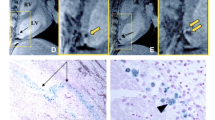Abstract
Objective
The conventional method for the analysis of myocardial cell transplantation depends on postmortem histology. Here, we have sought to demonstrate the feasibility of a longitudinal monitoring of transplanted cell survival in living animals, accomplished with optical imaging techniques and pharmacological interventions.
Methods
Human cord blood (50 ml) was donated with parental consent. After getting cord blood derived mesenchymal stem cells (CBMSCs), cells were transfected (MOI = 100) overnight with adenovirus encoding firefly luciferase gene (Ad-CMV-Fluc). Our experimental Sprague-Dawley rats (n = 12) were given intramyocardial injections containing 1 × 106 CBMSCs, which had been made to express the firefly luciferase (Fluc) reporter gene. Optical bioluminescence imaging was then conducted using a cooled charged-coupled device (CCD) camera (Xenogen), beginning on the day after the transplantation (day 1). Groups of mice were intraperitoneally injected with cyclosporine (5 mg/kg) or tacrolimus (1 mg/kg), in an attempt to determine the degree to which cell survival had been prolonged, and these values were then compared with the cell survival values of the negative control group. The presence of transplanted CBMSCs on in vivo images confirmed by in situ hybridization for human specific Alu in the myocardium.
Results
Cardiac bioluminescence signals were determined to be present for 6 days after transplantation: day 1 (97000 ± 9100 × 105 p/s/cm2/sr), day 3 (9600 ±1110 p/s/cm2/sr), and day 5 (3200 ± 550 p/s/cm2/sr). The six mice that received either cyclosporine or tacrolimus displayed cardiac bioluminescence signals for a period of 8 days after transplantation. We observed significant differences between the treated group and the non-treated group, beginning on day 3 (tacrolimus; 26500 ± 4340 p/s/cm2/sr, cyclosporine; 27200 ± 3340 p/s/cm2/sr, non-treated; 9630 ± 1180 p/s/cm2/sr, p < 0.01), and persisting until day 7 (tacrolimus; 12500 ± 2946 p/s/cm2/sr, cyclosporine; 7310 ±1258 p/s/cm2/sr, non-treated; 2460 ± 160 p/s/cm2/sr, p < 0.01). The human-derived CBMSCs were detected in the myocardium 3 days after transplantation by in situ hybridization.
Conclusions
The locations, magnitude, and survival duration of the CBMSCs were noninvasively monitored with a bioluminescence optical imaging system. We determined that optical molecular imaging expedites the fast throughput screening of pharmaceutical agents, allowing for the noninvasive tracking of cell survival within animals. In rat cardiac CBMSC transplant models, transient immunosuppressive treatment with tacrolimus or cyclosporine was shown to improve donor cell survival.
Similar content being viewed by others
References
Menasche P, Hagege AA, Vilquin JT, Desnos M, Abergel E, Pouzet B, et al. Autologous skeletal myoblast transplantation for severe postinfarction left ventricular dysfunction.J Am Coll Cardiol 2003; 41:1078–1083.
Strauer BE, Brehm M, Zeus T, Kostering M, Hernandez A, Sorg RV, et al. Repair of infarcted myocardium by autologous intracoronary mononuclear bone marrow cell transplantation in humans.Circulation 2002; 106:1913–1918.
Stamm C, Westphal B, Kleine HD, Petzsch M, Kittner C, Klinge H, et al. Autologous bone-marrow stem-cell transplantation for myocardial regeneration.Lancet 2003; 361:45–6.
Orlic D, Hill JM, Arai AE. Stem cells for myocardial regeneration.Circ Res 2002; 91:1092–1102.
Reinlib L, Field L. Cell transplantation as future therapy for cardiovascular disease? A workshop of the National Heart, Lung, and Blood Institute.Circulation 2000; 101:El82–187.
Aicher A, Brenner W, Zuhayra M, Badorff C, Massoudi S, Assmus B, et al. Assessment of the tissue distribution of transplanted human endothelial progenitor cells by radioactive labeling.Circulation 2003; 107:2134–2139.
Kraitchman DL, Heldman AW, Atalar E, Amado LC, Martin BJ, Pittenger MF, et al.In vivo magnetic resonance imaging of mesenchymal stem cells in myocardial infarction.Circulation 2003; 107:2290–2293.
Wu JC, Chen IY, Sundaresan G, Min JJ, De A, Qiao JH, et al. Molecular imaging of cardiac cell transplantation in living animals using optical bioluminescence and positron emission tomography.Circulation 2003; 108:1302–1305.
Wu JC, Inubushi M, Sundaresan G, Scheiben HR, Gambhir SS. Optical imaging of cardiac reporter gene expression in living rats.Circulation 2002; 105:1631–1634.
Wu JC, Tseng JR, Gambhir SS. Molecular imaging of cardiovascular gene products.J Nucl Cardiol 2004; 11:491–505.
Wu JC, Chen IY, Gheysens O, Wang D, Gambhir SS. Comparison of cyclosporin versus tacrolimus immunosuppression for improving cell survival after transplantation, [abstract]Mol Imaging Biol 2005; 7:p81.
Author information
Authors and Affiliations
Corresponding authors
Rights and permissions
About this article
Cite this article
Min, JJ., Moon, S., Kim, S.M. et al. In vivo bioluminescence imaging of cord blood derived mesenchymal stem cell transplantation into rat myocardium. Ann Nucl Med 20, 165–170 (2006). https://doi.org/10.1007/BF03027425
Received:
Accepted:
Issue Date:
DOI: https://doi.org/10.1007/BF03027425




